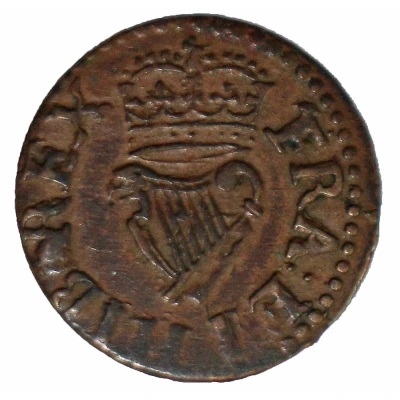


© John Conduitt (CC BY-SA)
1 Farthing - Charles I Richmond issue; type 3 ND
| Copper | 0.49 g | 16 mm |
| Issuer | England (United Kingdom, British Overseas Territories and Crown Dependencies) |
|---|---|
| King | Charles I (1625-1649) |
| Type | Token |
| Years | 1631-1632 |
| Value | 1 Farthing (1⁄960) |
| Currency | Pound sterling (1158-1970) |
| Composition | Copper |
| Weight | 0.49 g |
| Diameter | 16 mm |
| Shape | Round (irregular) |
| Technique | Roller milled |
| Orientation | Medal alignment ↑↑ |
| Demonetized | Yes |
| Updated | 2024-10-09 |
| Numista | N#367708 |
|---|---|
| Rarity index | 95% |
Reverse
Eagle-headed, 5-string harp below single-arch crown, 9 jewels on band of crown, legend around.
Note: apostrophe stops
Script: Latin
Lettering: FRA! ET HIB! REX(.)
Unabridged legend: Franciae Et Hiberniae Rex
Translation: France and Ireland, King (continuation of obverse legend)
Comment
House of Stuart (1603-49), Charles I (1625-49), Richmond farthing Everson type 3 106-7 (Peck type 1d 196 and 198). Roller milled at the London Token House.Apostrophe stops, mintmark on obverse only. Two mintmark varieties exist: lion rampant (with 6-string harp); trefoil (with 5 string harp). Trefoil sometimes has a stop after REX.
In 1623, towards the end of the reign of James I, Ludovic, Duke of Lennox, acquired the additional title of the Duke of Richmond but died a few months later without an heir. The farthing patent passed to his widow, Frances Stewart, Dowager Duchess of Richmond and Lennox, who had as partner in it, Sir Francis Crane. This patent was confirmed to them on 30th May, 1625, by Charles I upon his accession. Thus, the first ‘farthing’ issues of Charles I are consequently called Richmonds.
Interesting fact
One interesting fact about the Token 1 Farthing - Charles I (Richmond issue; type 3) ND (1631-1632) from England (United Kingdom, British Overseas Territories and Crown Dependencies) made of Copper weighing 0.49 g is that it was issued during a time of great economic turmoil in England. The coin was minted in 1631-1632, during the reign of King Charles I, when the country was facing a severe shortage of small change, which led to the issuance of privately minted tokens like this one. The coin's design features the king's portrait on one side and a crowned coat of arms on the other, and its copper composition was a departure from the traditional silver or gold used in earlier coins. Despite its small denomination, the Token 1 Farthing was an important part of everyday commerce during its time and is now a sought-after collector's item.



